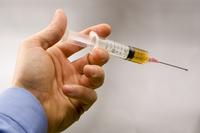-
Field Forensics launches quick opium detection kit
Field Forensics Inc., a U.S. developer of explosives detection and containment equipment, recently unveiled a new kit designed to detect a core chemical used to manufacture heroin
-
-
Floyd County gets additional $75,000 for CBRNE unit
Floyd County in Georgia has received two DHS grants worth $75,000 to replace and repair equipment for its chemical, biological, radiological, nuclear, and explosives (CBRNE) response unit; the bulk of the money, approximately $65,000, will go towards replacing aging equipment, while the rest will go towards repairs; the CBRNE team was originally created four years ago with nearly $350,000 in DHS funding as part of the state’s terrorism prevention initiative
-
-
OSI Systems to develop advanced cargo screening system
Rapiscan Systems, the security division of OSI Systems, Inc., was recently awarded a $29 million contract with DHS’ Science and Technology Directorate to develop sophisticated new cargo screening systems; the program is designed to produce the next generation of non-intrusive cargo screening systems that will be capable of automatically detecting and identifying multiple threats and contraband including explosives, narcotics, and chemical weapons in cargo containers entering the United States by air, land, and sea.
-
-
Iraqi defector admits he duped U.S. about Saddam's WMD
On 5 February 2003, Secretary of State Colin Powell spoke before the UN Security Council, making the case for tough measures against Saddam Hussein — including a U.S. invasion to topple him; one of the key revelations in Powell’s speech was that in order to evade detection of its WMD program, Iraq had constructed mobile biowarfare labs; as was the case with many other assertions in Powell’s speech, this assertion, too, was false; the CIA analysts who wrote Powell’s speech relied on an Iraqi defector code-named Curveball, who was considered unreliable by German and Israeli intelligence; the man who pulled off one of the greatest confidence tricks in the history of modern intelligence now admits that everything he had said about the inner workings of Saddam Hussein’s biological weapons program was a flight of fantasy
-
-
Yemen buys cargo screeners
Yemen is deploying Z Backscatter Vans from Billerica, Massachusetts-based American Science and Engineering Inc. to screen cargo and vehicles for explosives and contraband
-
-
ICx Technologies: comprehensive, layered approach to security
At the recent ASIS exhibition and seminar, Homeland Security Newswire took the time to walk through the ICx Technologies booth and speak to some of their subject matter experts; CommandSpace® & ThreatSense™, solutions which provide a comprehensive, layered approach to perimeter security and chemical, biological, radiological and nuclear security for critical facilities, respectively, were on display
-
-
Harvard law students sue TSA over pat-downs, full-body scanning
Two Harvard law students sue TSA, seeking to rein in use of full-body scans and pat-downs at airports; this is at least the sixth suit filed against the TSA since the agency put the enhanced screening procedures into widespread use following the so-called underwear bomber’s unsuccessful attempt to blow up a plane last Christmas with explosives hidden beneath his clothes; the pat-downs, which include “prodding and lifting of genitals and buttocks,” is so intrusive that, “if done non-consensually, would amount to sexual assault in most jurisdictions,” the Harvard students’ complaint says
-
-
TSA: Religion offers no exemption from airport screening

An airline passenger was thrown out of the San Diego airport for rejecting a full-body scan and pat-down groin check and instead insisting on passing through a metal detector; the Transportation Security Administration (TSA) says the agency will not allow airline passengers to get out of body imaging screening or pat-downs based on their religious beliefs; TSA chief John Pistole said that passengers who refuse to go through a full-body scanner machine and reject a pat-down will not be allowed to board, even if they turned down the in-depth screening for religious reasons; “That person is not going to get on an airplane,” Pistole said yesterday in a congressional committee testimony
-
-
Drive-by X-ray vans raise privacy, health worries
DHS, the U.S. military, and even local law enforcement agencies are buying and deploying mobile X-ray vans that can see into the interior of vehicles around them; the Z Backscatter Van (ZBV), manufactured by American Science and Engineering (AS&E), can be used to detect contraband such as car bombs, drugs, and people in hiding; the van looks like a standard delivery van, and it takes less than fifteen seconds to scan passing vehicles; it can be operated remotely from more than 1,500 feet and can be equipped with optional technology to identify radioactivity as well; the vans, which can also see through clothing and into some buildings, are raising privacy concerns as well as questions about health risks — and what might happen if the technology gets into the wrong hands
-
-
Insect-size air vehicles to explore, monitor hazardous environments
High-performance micro air vehicles (MAVs) are on track to evolve into robotic, insect-scale devices for monitoring and exploration of hazardous environments, such as collapsed structures, caves and chemical spills
-
-
Pentagon shifts $1 billion from WMD-defense efforts to vaccine development

The Obama administration has shifted more than $1 billion out of its nuclear, biological, and chemical defense programs to underwrite a new White House priority on vaccine development and production to combat disease pandemics; Defense Department projects under the budget-cutting ax include the development and acquisition of biological and chemical detection systems; gear to decontaminate skin and equipment after exposure; systems to coordinate military operations in a chem-bio environment; and protective clothing for military personnel entering toxic areas, the document indicates
-
-
Flir to acquire sensor maker ICx for $274 million
Flir, maker of thermal imaging technology, is acquiring ICx for $274 million; the merger will give Flir the capability to expand into the market for advanced sensors for chemical, biological, radiological, and nuclear explosives (CBRN) detection for homeland security and defense
-
-
Evidence shows Turkish use of chemical weapons against Kurdish fighters
German medical experts have confirmed the authenticity of photographs showing eight dead Kurdish PKK fighters — and that the photos prove that they were killed by “chemical substances”; Turkey has been suspected for a while now of using chemical weapons against Kurdish militants, and German politicians across the political spectrum, as well as human rights organizations, have called on Turkey to explain the findings; Turkey denies the charges, calling them “PKK propaganda”
-
-
India equipped to protect the October Commonwealth Games against WMD attacks
India will have a big security challenge when the Commonwealth Games begin in October; Indian security agencies say they are equipped to face chemical, biological, radiological, and nuclear (CBRN) terrorist threats during the games; intelligence agencies have been working on the possibility of attacks from Kashmiri groups like the Hizbul Mujahidden, the Pakistan-based Lashkar-e-Taiba (LeT), the Taliban from Pakistan or Afghanistan, and even Al Qaeda; militant outfits of various other ideological hues are also on the police radar
-
-
NY Naval Militia in WMD detection homeland security exercise on Hudson River
Several New York States government agencies take part in an exercise on the Hudson River aimed to examine radiation detection capabilities; the exercise was part of Trojan Horse 2010 an annual maritime security training exercise sponsored by State University of New York Maritime College
-
- All
- Regional
- Water
- Biometrics
- Borders/Immig
- Business
- Cybersecurity
- Detection
- Disasters
- Government
- Infrastructure
- International
- Public health
- Public Safety
- Communication interoperabillity
- Emergency services
- Emergency medical services
- Fire
- First response
- IEDs
- Law Enforcement
- Law Enforcement Technology
- Military technology
- Nonlethal weapons
- Nuclear weapons
- Personal protection equipment
- Police
- Notification /alert systems
- Situational awareness
- Weapons systems
- Sci-Tech
- Sector Reports
- Surveillance
- Transportation
Advertising & Marketing: advertise@newswirepubs.com
Editorial: editor@newswirepubs.com
General: info@newswirepubs.com
2010-2011 © News Wire Publications, LLC News Wire Publications, LLC
220 Old Country Road | Suite 200 | Mineola | New York | 11501
Permissions and Policies
Editorial: editor@newswirepubs.com
General: info@newswirepubs.com
2010-2011 © News Wire Publications, LLC News Wire Publications, LLC
220 Old Country Road | Suite 200 | Mineola | New York | 11501
Permissions and Policies
